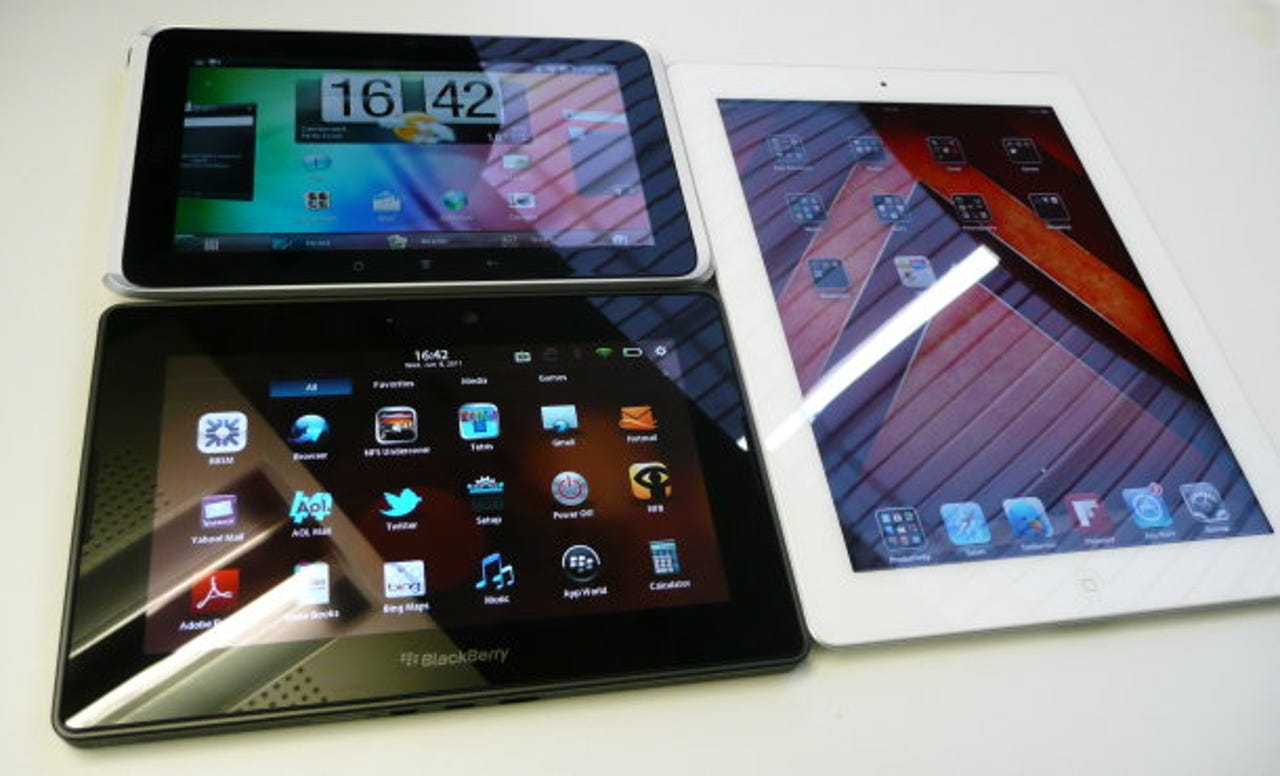Take two tablets? Why owning more than one slate is the future

When one iPad is not enough...

Deloitte: Five million tablets will be sold to tablet-owning homes this yearPhoto: Natasha Lomas/silicon.com
So you've got one tablet - how about buying another? Professional services firm Deloitte is predicting almost five per cent of global tablet sales this year - some five million slates - will be to individuals or households that already own a tablet.
While this figure represents a small proportion of total global tablet sales, Deloitte notes that, given the tablet market is only three years old, it is likely to represent "the most rapid 'multi-anything' market penetration in history".
"The 75 million modern tablet computers sold since they launched in 2010 have clearly proven the demand for a device with dimensions and processing power somewhere between a smartphone and a laptop," the company notes in its Technology, Media and Telecommunications Predictions 2012 report. "It took several decades after introduction for more than five per cent of households to have more than one car, phone, radio or TV. More recently, over 10 years passed before five per cent of homes had more than one personal computer or cell phone."
The rise of people owning more than one tablet - apparently dubbed "scatter cushion computing" - is part of a long-term trend of steadily rising computer use and ownership, according to the firm. The main drivers for having two tabs will be size, new form factors, price points and vendor business models, it predicts.
Another driver is likely to be enterprises deploying specific tablet models that have been cleared for employee use, according to Deloitte. It reckons businesses will choose to issue these tablets for reasons that include boosting security, improving compatibility with existing operating systems and ensuring more rugged tablet hardware.
More than 80 per cent of the tablets sold to date have shared roughly the same key features: being iPad-sized (10 inches) with a single LCD capacitive touchscreen, having wi-fi but no 3G, weighing around 650g and having an average selling price of $600 - the report notes. However Deloitte predicts this tablet homogeneity will be diluted this year as offerings become more varied and demand follows suit.
"As with smartphones, a category which now describes multiple types of devices, tablets will become increasingly diversified by size, processor power, operating system and business model," the report notes.
When it comes to buying a second tablet, buyers are likely to plump for a smaller size, Deloitte reckons - i.e. with a screen size ranging from five to seven inches (or from a Dell Streak to a BlackBerry PlayBook). It predicts tens of millions of these mini slates will ship by year's end, versus only a few million during 2011.
Smaller slates are likely to be used differently to the iPad-sized tablet form factor - Deloitte points to email and book reading, photo viewing, and using apps designed for smartphones as likely use-cases for small slates. While reading business documents, analysing data, reviewing presentations, browsing full website and magazines, writing documents or watching long-form video is better suited to iPad-sized tablets, it says.
Deloitte's report also predicts 2012 will see increasing numbers of tablet owners and smartphone users use their devices as portable DVRs during their commute, to catch up on an estimated five billion hours of TV programming. "Tablets and smartphones can now be thought of as portable DVRs. The falling price of memory means that storing video in sufficient quality is not a major challenge," the report notes.
Deloitte sees near field communications (NFC) data transfer technology growing in 2012 too, with the number of NFC-enabled devices set to swell by 100 per cent to almost 200 million devices. Next year it predicts there will be around 300 million NFC-enabled smartphones, tablets and e-readers sold.
But just because NFC is being added to devices doesn't mean consumers will adopt contactless payments en masse. Deloitte's report suggests the large installed base of older retail POS terminals, which have not been enabled for contactless payment use, could hold down NFC transactions levels until 2013. It also points to the availability of contactless credit and debit cards as potentially slowing adoption of contactless devices by offering an alternative way to wave and pay.
"Over the long run, NFC-enabled devices are likely to find a wide array of uses - especially for payments. But even in 2012, NFC capability will be used for a surprisingly diverse range of non-payment applications, including gaming, security, authentication and information," the report adds.
Another prediction is the rise of the $100 'smartphone' this year - a device which resembles a smartphone in appearance, sporting a touchscreens or full Qwerty keyboard, yet may not actually run a smartphone OS or allow users to download apps.
Deloitte predicts there will be half a billion of these $100 or cheaper smartphone-a-likes in use globally by the end of the year. These phones aren't likely to have 3G but will provide access to email, IM and the mobile web, and include a selection of pre-loaded apps and widgets, plus a basic camera, the report notes.